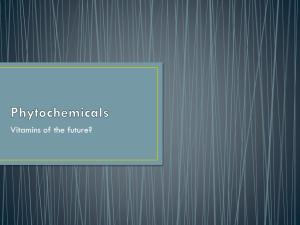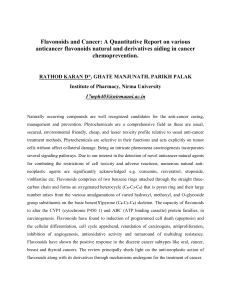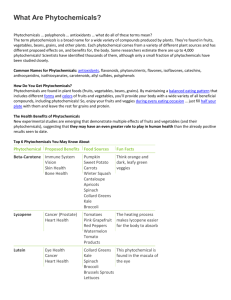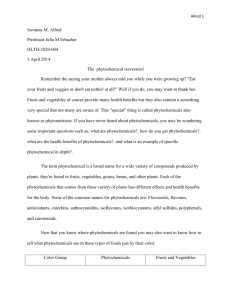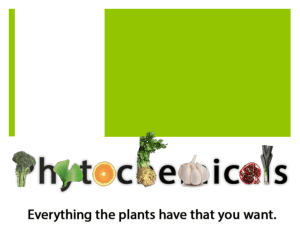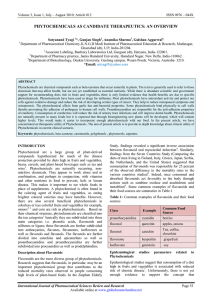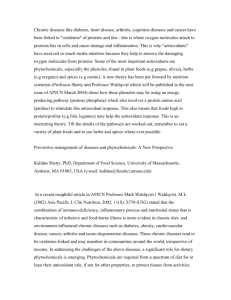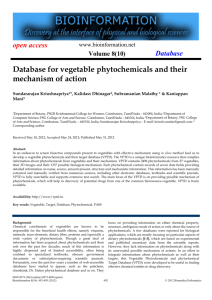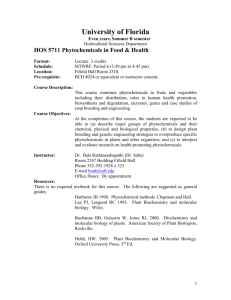Phytochemicals - UC Davis Department of Nutrition
advertisement
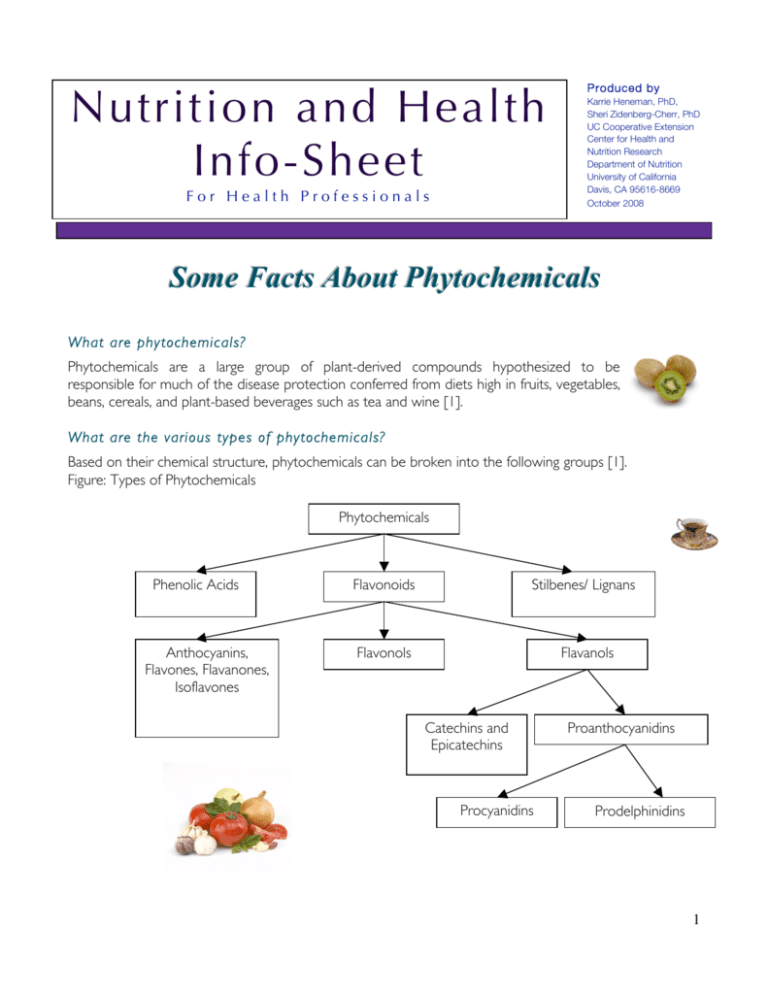
Nutrition and Health Info-Sheet For Health Professionals Produced by Karrie Heneman, PhD, Sheri Zidenberg-Cherr, PhD UC Cooperative Extension Center for Health and Nutrition Research Department of Nutrition University of California Davis, CA 95616-8669 October 2008 Some Facts About Phytochemicals What are phytochemicals? Phytochemicals are a large group of plant-derived compounds hypothesized to be responsible for much of the disease protection conferred from diets high in fruits, vegetables, beans, cereals, and plant-based beverages such as tea and wine [1]. What are the various types of phytochemicals? Based on their chemical structure, phytochemicals can be broken into the following groups [1]. Figure: Types of Phytochemicals Phytochemicals Phenolic Acids Anthocyanins, Flavones, Flavanones, Isoflavones Flavonoids Stilbenes/ Lignans Flavonols Flavanols Catechins and Epicatechins Procyanidins Proanthocyanidins Prodelphinidins 1 What are flavonoids? Flavonoids are the most diverse group of phytochemicals. Research suggests that flavonoids, in particular, may be an important phytochemical group that contributes to the reduced mortality rates observed in people consuming high levels of plant-based foods. In the Zutphen Elderly Study, findings revealed a significant inverse association between flavonoid intake and myocardial infarction [2]. Similarly, findings from the Seven Countries Study (comparing the diets of men living in Finland, Italy, Greece, the former Yugoslavia, Japan, Serbia, the Netherlands, and the United States) suggested that consumption of flavonoids was responsible for 25 percent of the observed difference in mortality rates in the various countries studied [3]. Indeed, once consumed and absorbed, flavonoids act favorably in the body, through actions such as inhibiting xanthine oxidase and arachidonic acid metabolism [4]. What are some examples of flavonoids and their food sources? Class Example Common Food Source Flavonol Quercetin Apples, Onions Flavanol Catechin Tea, Coffee, Chocolate Isoflavone Genistein Soy Flavonone Hesperitin Grapefruit Anthocyanidin Cyanidin Berries What is the evidence that phytochemicals protect against disease? Epidemiological studies suggest that consumption of a diet high in fruits and vegetables is associated with a reduced risk of chronic disease [5]. Unfortunately, there is not yet enough evidence to support the concept that phytochemicals are responsible for these effects. Fruits and vegetables are important sources of a variety of beneficial agents including vitamins, minerals, fiber, and phytochemicals. More research is needed to fully explain the actions of phytochemical compounds in the human body [6]. Why is it important to eat a variety of plant-based foods? Hundreds of phytochemical compounds, with several different biological functions, have been identified in plant-based foods. Therefore, consuming a variety of plant-based foods helps to ensure that individuals receive the optimum benefits from the fruits and vegetables consumed [7]. 2 What are the potential health benefits from some phytochemical compounds? Food Soy Beans, Soy Milk, and Tofu Phytochemical Possible Benefit Isoflavones (Genistein and A reduction in blood pressure and Daidzein) increased vessel dilation [8] Improvement of vision, inhibition of nitric oxide production, induction of apoptosis, decreased platelet aggregation, and neuroprotective effects [8] Inhibition of LDL oxidation, inhibition of cellular oxygenases, and inhibition of proinflammatory responses in the arterial wall [8] Strawberries, Red Wine, Blueberries Anthocyanins Red Wine, Grape Juice, Grape Extracts, Cocoa Proanthocyanidins and flavan-3-ols Garlic, onions, leeks, olives, scallions Sulfides, thiols Decrease in LDL cholesterol [9] Carotenoids such as lycopene, beta-carotenes Neutralization of free radicals that cause cell damage [9] Isothiocyanates (sulforaphane) Neutralization of free radicals that cause cell damage [9] and protection against some cancers [10] Carrots, tomatoes, and tomato products, and various types of fruits and vegetables Broccoli and other cruciferous vegetables such as kale, horseradish What is the recommended intake of phytochemicals? Due to the lack of food composition data and a true understanding of the absorption and metabolism of phytochemical compounds, the Standing Committee on the Scientific Evaluation of Dietary Reference Intakes and Its Panel on Dietary Antioxidants and Related Compounds of the Food and Nutrition Board at the Institute of Medicine chose not to create a Dietary Reference Intake (DRI) for these compounds [11]. Therefore, a recommended intake for phytochemicals does not currently exist. Today, many health authorities such as the American Cancer Society and the American Heart Association recommend consuming a diet high in fruits and vegetables to ensure that an individual ingests an adequate amount of phytochemical compounds [12, 13]. Should people take phytochemical supplements? The long-term effects of pharmacological doses of phytochemicals on human health are not well understood and therefore supplementation is not recommended. Furthermore, the relationship between food and health is complex. By replacing foods with supplements, beneficial food components or important interactions between food components may be lost. Current evidence still supports that consumption of a balanced diet, high in a variety of fruits, vegetables, and whole grain foods, is associated with optimal health [6]. 3 References: 1. Arts, I.C. and P.C. Hollman, Polyphenols and disease risk in epidemiologic studies. Am J Clin Nutr, 2005. 81(1 Suppl): p. 317S-325S. 2. Hertog, M.G., et al., Dietary antioxidant flavonoids and risk of coronary heart disease: the Zutphen Elderly Study. Lancet, 1993. 342(8878): p. 1007-11. 3. Hertog, M.G., et al., Flavonoid intake and long-term risk of coronary heart disease and cancer in the seven countries study. Arch Intern Med, 1995. 155(4): p. 381-6. 4. Nijveldt, R.J., et al., Flavonoids: a review of probable mechanisms of action and potential applications. Am J Clin Nutr, 2001. 74(4): p. 418-25. 5. Hung, H.C., et al., Fruit and vegetable intake and risk of major chronic disease. J Natl Cancer Inst, 2004. 96(21): p. 1577-84. 6. Halliwell, B., Dietary polyphenols: good, bad, or indifferent for your health? Cardiovasc Res, 2007. 73(2): p. 341-7. 7. Manach, C., et al., Polyphenols: food sources and bioavailability. Am J Clin Nutr, 2004. 79(5): p. 72747. 8. Erdman, J.W., Jr., et al., Flavonoids and Heart Health: proceedings of the ILSI North America Flavonoids Workshop, May 31-June 1, 2005, Washington, DC. J Nutr, 2007. 137(3): p. 718S-37S. 9. Dinkova-Kostova, A.T., Phytochemicals as Protectors Against Ultraviolet Radiation: Versatility of Effects and Mechanisms. Planta Med, 2008. 10. Juge, N., R.F. Mithen, and M. Traka, Molecular basis for chemoprevention by sulforaphane: a comprehensive review. Cell Mol Life Sci, 2007. 64(9): p. 1105-27. 11. Standing Committee on the Scientific Evaluation of Dietary Reference Intakes and Its Panel on Dietary Antioxidants and Related Compounds, Dietary Reference Intakes: Proposed Definition and Plan for Review of Dietary Antioxidants and Related Compounds, in Dietary Reference Intakes, N.A. Press, Editor. 1998, Institute of Medicine: Washington, D.C. p. 1-13. 12. American Cancer Society. Phytochemicals. [cited; Available from: http://www.cancer.org/docroot/ETO/content/ETO_5_3X_Phytochemicals.asp?sitearea=ETO. 13. American Heart Association. Phytochemicals and Cardiovascular Disease. [cited; Available from: http://www.americanheart.org/presenter.jhtml?identifier=4722. Production of this material was supported by a grant from the Vitamin Cases Consumer Settlement Fund, created as a result of an antitrust class action. One of the purposes of the fund is to improve the health and nutrition of California consumers. The University of California prohibits discrimination or harassment of any person on the basis of race, color, national origin, religion, sex, gender identity, pregnancy (including childbirth, and medical conditions related to pregnancy or childbirth), physical or mental disability, medical condition (cancer-related or genetic characteristics), ancestry, marital status, age, sexual orientation, citizenship, or service in the uniformed services (as defined by the Uniformed Services Employment and Reemployment Rights Act of 1994: service in the uniformed services includes membership, application for membership, performance of service, application for service, or obligation for service in the uniformed services) in any of its programs or activities. University policy also prohibits reprisal or retaliation against any person in any of its programs or activities for making a complaint of discrimination or sexual harassment or for using or participating in the investigation or resolution process of any such complaint. University policy is intended to be consistent with the provisions of applicable State and Federal laws. Inquiries regarding the University’s nondiscrimination policies may be directed to the Affirmative Action/Equal Opportunity Director, University of California, Agriculture and Natural Resources, 1111 Franklin Street, 6th Floor, Oakland, CA 94607, (510) 987-0096. 4


